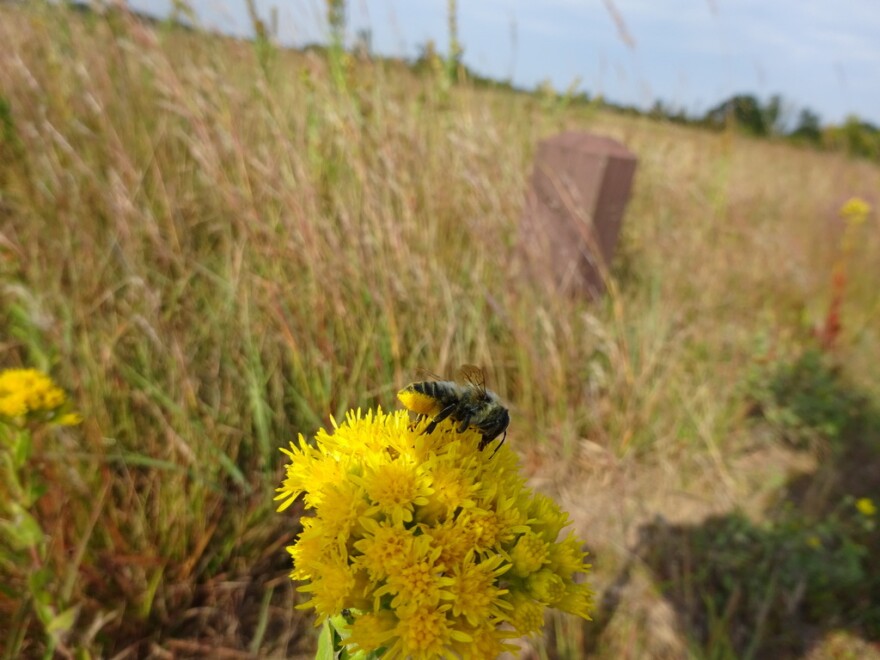Most people picture a hive when thinking of bees, complete with a distinctive shape and a flurry of buzzing and activity all around it.
But the majority of bees live and nest on their own, including tunnel-nesting bees. University of Minnesota Bee Atlas project coordinator Thea Evans joined Heidi Holtan and John Latimer for the June installment of KAXE's series about the decline of native pollinators. Their focus was on Minnesota’s tunnel-nesting bees, which are solitary bees that nest in plant stems and wood.
The discussion ranged from which plants these bees use to construct their nests, how native bees are the most important pollinators on the continent, and how community members can help study and conserve native bee populations.

Beelining for a baseline
The Bee Atlas project is particularly important because native bees have been historically understudied. Currently, about 500 native species are known to occur in Minnesota: dozens more are being discovered every year. Approximately one-fifth of these species are tunnel-nesting bees that use dead wood or plant stems to house their nests.
Each nest is comprised of multiple capsules, each containing one larva, food and enclosed in protective plant material. Little is currently known about which plant species these bees use while constructing the nesting capsules. The Bee Block project aims to fix this, by using DNA and resin analyses to identify the plants used by tunnel-nesting bees.

These studies are essential to establish a baseline knowledge of the bees present in the state, their distribution, and which plant species they depend on. While it's clear that native pollinators are declining, it is difficult for researchers to determine how the relative effects of habitat loss, pesticide exposure, disease and parasitism, and climate change interact to affect the populations.
“These are all factors that impact the bees, but we know a lot less about how these factors are affecting the populations of these bees,” Evans said. “And that’s partly because there hasn’t been a lot of baseline.”
“These are all factors that impact the bees, but we know a lot less about how these factors are affecting the populations of these bees. And that’s partly because there hasn’t been a lot of baseline.”Thea Evans
Bee blocks
One phase of the Bee Atlas project investigates how tunnel-nesting bees use plants to build their nests. Volunteers receive ‘bee blocks’ (nesting habitats made of wood with pre-drilled holes) and monitor them for nesting activity.
When the season ends, the bee blocks are sent back to the researchers, who analyze which species are present, the condition of the larvae, and determine which plant species are used to create, line and cap the nests. The larvae are reared and released the next season.
Leaf-cutting bees are a good example of these bee species’ reproductive strategy. As their name suggests, these bees harvest sections of leaves, which act as small “sleeping bags” for their larvae. The mother bee begins by memorizing the location of a suitable tunnel or stem. Then, she builds tiny larval sleeping bags, or capsules, out of leaf sections. Once the capsule is complete and supplied with food, the bee lays an egg, caps the capsule and builds another one. This process continues until the tunnel is full.
Effective pollinators

Native bees are responsible for the overwhelming majority of pollination — and thus, continued survival — of wild plants. Wild, native bees are more efficient at achieving pollination, or moving pollen from plant to plant, compared to honeybees.
Even in agricultural areas where commercial bumblebees or honeybees are brought in to assist with pollination, wild native bees accomplish a significant proportion of the work.
Helping bees
One of the best ways to help native pollinators is to plant native plants. Aim for a mix of early-, mid-, and late-blooming species to ensure bees have a supply of nectar and pollen throughout the season. You can help tunnel-nesting bees by allowing nature to take its course on dead wood and stems, which provide such essential nesting habitat for these species.
You can also assist researchers by posting your bee observations to iNaturalist: the Minnesota Bee Atlas project is a great place for information, identification and aiding scientists.
Funding for this project was provided by the Minnesota Environment and Natural Resources Trust Fund as recommended by the Legislative-Citizen Commission on Minnesota Resources (LCCMR).








